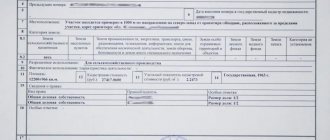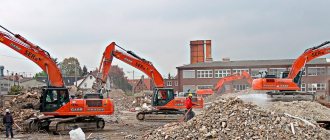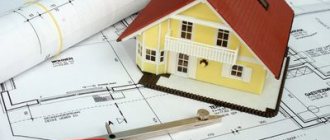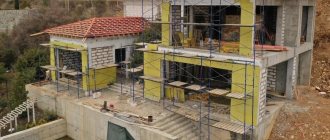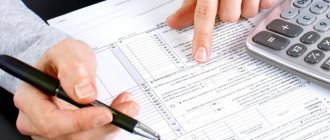Submission rules
The rules for entering information into the State Property Committee are regulated by Federal Law No. 221. This is the main document in which you can find answers to all questions regarding the cadastre.
Federal Law No. 221 also regulates the procedure for providing data from the State Tax Committee, which we will discuss below.
Information is entered into the State Property Committee as follows:
- The cadastral registration authority decides that the object (plot or building) needs to be registered with the State Property Committee. This usually occurs as a result of an application by the owner of the property.
- The employee assigns this object its unique cadastral number.
- The employee enters the number and other characteristics of the object in the Civil Code. Naturally, to do this, you first need to know all the characteristics. Therefore, if necessary, examinations and other assessment procedures are carried out.
- The registration authority issues the property its cadastral passport.
If the owner of a property does not have a cadastral passport, then he should also contact the registration authorities. This document can be obtained by providing title documents for the object.
Information about objects in the Unified State Register of Real Estate
According to the Law “On State Registration of Real Estate” No. 218-FZ of July 13, 2015, each of the real estate properties (owned or managed by individuals or legal entities) must be registered in the Unified State Register of Real Estate (USRN).
In its current form, the USRN is a systematized database that contains:
- accounting and technical information – information about the main characteristics of the property, regardless of its location;
- information about copyright holders - information about legal entities and individuals in whose possession (management) or ownership the objects are located;
- information about transitions of ownership that have taken place (changes of copyright holder).
Composition of State Property Committee information on a real estate property
The information contained in the GKN is quite voluminous. First, let's look at the general list, and then we'll look at its key points in more detail.
So, the GKN contains the following data:
- about various real estate objects;
- on the state border of the Russian Federation;
- about the borders between different territorial units of the Russian Federation;
- about the boundaries of cities and other populated areas;
- on special territorial zones;
- about cadastral division;
- about geodetic basis and cartographic basis.
The most popular part of the cadastre among ordinary citizens of the Russian Federation is information about real estate. It is this in the form of an extract that is most often provided to people who apply for a particular issue. It is also contained in the cadastral passport.
Let's consider the nature of information about real estate contained in the State Property Committee:
- Information about the unique parameters of land plots . This category includes: type of plot, cadastral number, description of boundaries, area, as well as numbers of neighboring plots.
- Additional data on land plots . This category includes all information that does not belong to the previous group. This is the conventional number of the site, its address or description of the location, a description of the category of land to which it belongs, and the features of this category. If an object was formed from another (or, conversely, forms another) - then the cadastral numbers of each of them also refer to additional data.
- Information about unique building parameters . This group includes: the type of building, its cadastral number and date of inclusion in the Civil Code, the area of the building, a description of its location with coordinates on the ground and possible errors.
- Additional information about buildings . This category contains everything the same as in a similar category for land plots. In other words, all “technical” information about the building that is not included in the list of unique parameters.
GKN is a place where you can find any information about a piece of land or real estate. If a person needs to obtain some kind of extract regarding real estate, then almost always this needs to be done from the cadastre authorities.
Composition of information from the State Property Committee
All information about real estate objects is listed in the unified state register of real estate, which includes the Unified State Register and the State Property Committee.
Let us describe in detail what data is reflected in the State Tax Code:
- type of real estate (land, building, construction);
- cadastral number of a plot of land, building, structure or real estate under construction;
- location on the ground of the boundaries of a plot of land, building, structure or real estate under construction;
- area of land, building or premises;
- information about transactions with objects (purchase, sale, change of boundaries, shares, change of owners),
- presence of encumbrances.
The law regulating the principles of maintaining, including the composition of data, the State Real Estate Cadastre is Federal Law No. 221 of July 24, 2007.
GKN consists of the following sections:
- Register of immovable objects.
- Databases of cadastral files and cadastral maps.
What form does the information in the cadastre take?
The information is in open form. This means that anyone can access them if they have the necessary reasons. But for this he must have ownership rights to the real estate. Only data on special-purpose objects or objects prohibited for private use are stored in a closed form.
All data contained in the cadastre is strictly systematized. Employees of cadastral registration authorities enter data in the prescribed form and issue them in the same way. Therefore, all cadastral passports and extracts are unified. Information is always organized and technically perfect.
What it is?
An extract from the State Property Committee is a document that displays all the necessary information about any required real estate. It may be necessary to obtain it in several cases:
- To resolve disputes by court decision;
- To carry out transactions related to real estate.
You can obtain this document from Rosreestr, since the State Real Estate Cadastre is maintained by this organization. This organization also provides services for issuing the required information from this register.
There are several ways to obtain this document:
- Use the online application form posted on the organization’s website;
- Visit the branch and personally ask for a certificate.
Not only owners of real estate may need an extract from the State Property Committee. Considering the fact that the vast majority of information is freely available, if desired, anyone can order an extract to verify the accuracy of the data and learn about the property in more detail.
If a certificate for a land plot is required, it can be obtained by contacting the cadastre. The GKN, created after 2007, is a powerful and complete resource. It displays information not only about the land, but also about all the structures and buildings located on it.
As with residential space, an extract from the State Property Committee should be obtained from Rosreestr. A distinctive feature of the passport is the presence of information about the boundaries of the site.
A sample extract from the Unified State Register of Real Estate about the main characteristics and registered rights, which you will receive through the widget:
A sample extract from the Unified State Register of Real Estate on the transfer of rights to a property, which you will receive through the widget:
Nature of data
“Nature of information” is one of the points contained in any cadastral extract or cadastral passport. It is this point that usually raises questions among people, because it is very difficult to understand it without knowledge of the legislation of the Russian Federation.
In other words, the nature of the information is the status of the entry of a site or building into the cadastre.
The object has already gone through the cadastral registration process and was entered into the register, but due to the nature of the process, different statuses may be applied to it:
- recorded information;
- previously taken into account;
- archival;
- temporary;
- canceled.
The nature of the information changes in accordance with the provisions of Federal Law No. 221. Next, we will talk about why information in the cadastre often has a “temporary” status, and how to change it to the necessary “recorded” status.
What does "temporary" status mean?
Typically, the status “temporary” is assigned to information that is not registered in the State Register. This means that the property was registered in the cadastre, but its owner also needs to contact the Unified State Register of Real Estate.
It is there that the ownership of the object is registered. If such registration is not carried out within 5 years from the date of cadastral registration, the status of the information will change from “temporary” to “cancelled”. And with timely registration, it changes to “accounted for.”
Thus, the “temporary” status of the data is absolutely normal. It is received by absolutely all plots and buildings, the owner of which has not yet registered his rights in the Unified State Register of Real Estate. The law proposes to do this within 5 years, so that is more than enough time.
The technical passport of a building reflects many of its characteristics, but primarily the area. The total area of the building, the area of personal, common and technical premises, common areas, mine structures, roofing, etc. These parameters are extremely important and primarily characterize the property - its salable (rented) area, the volume of office and technical premises, the area to be cleaned, etc.
RF standards (BTI)
The sum of all Rented areas is equal to the sum of all usable areas of the building and the areas of the MOP.
Σ (S ri ) = Σ (S ui ) + Σ (Smop ); [2]
R/U coefficients are calculated for each floor and for the building as a whole using the formulas:
R / U ( f ) = 1 + Σ( Smop ( f ))/Σ( Su ( f )); [3]
R / U ( b ) = 1 + Σ( Smop ( b ))/Σ( Su ( b )); [4]
At the same time, the premises of the MOP building mainly include premises on the first floor, such as the reception room and entrance halls. The areas of publicly accessible restaurant halls are included both in the areas rented by restaurateurs and in the building's MOP, as a rule, on a parity basis - 50% each.
It is easy to see that the use of BOMA standards guarantees the unchanged main characteristics of the building: the total area of the premises does not change either after finishing, or even after deep redevelopment.
BTI standards, on the contrary, assume a natural change in the area of premises (and the building as a whole) over time, so the technical passport of the premises in this case must be periodically updated. It turns out that the property may “lose weight” over time or, conversely, gain “weight.” The variability of the area of real estate, in our opinion, is a rather dubious achievement of domestic officials during the period of developed socialism.
It would not be amiss to remember that modern design techniques for arranging premises often lead to cases where the floor area and the area of the room “from wall to wall” are far from the same thing.
BOMA standards could be applied when determining the owner’s share in the premises of common shared ownership of an apartment building (hereinafter - MKD , House ). The law only says that “The share in the right of common ownership ... of the owner of the premises ... is proportional to the size of the total area of the specified premises” (LC, art.). Hence, assuming that the sum of all shares is 100%, it can be shown that the Share in the right to the common property of the owner of premises No. i is the ratio of areas:
Di = So i/ Smkd; [5]
Where:
Sо i – total area of personal premises No. i;
Smkd – the total area of all premises of personal property (LP) of the House;
Smkd = Σ So (i); (i = 1..N); [6]
N – number of personal premises in the apartment building;
µ hereinafter, by premises of personal property (or personal premises) we mean premises that are in the personal property (of individuals or legal entities), as opposed to premises that are in common use. We will mark with the sign “µ” original author’s proposals that have not yet entered into widespread practice.
The sum of all shares, as can be seen from [5] and [6]:
Σ D(i) = Σ So (i)/Smkd = 1; (or 100%) [7]
The share in the right to common property, determined by area using BTI methods, will also fluctuate depending on the repairs made in each apartment. Moreover, renovations in one apartment i can change the shares (albeit slightly) of all (!) owners of premises in the house. To avoid – construction area
Applying BOMA international standards for apartment buildings, we introduce here the concept of the shared area of the premises as the sum of the total area of the premises, taking into account the share in the right to the premises of common shared ownership ( CHP ).
µ Sд i = So i + Sods * D i; [8]
Where:
Sд i – fractional area of room No. i;
Sods – the total area of all premises of the building’s building;
Di is the share in the right to the common property of the apartment building (it is also the share in the right to the premises of the community building) relating to premises No. i - a dimensionless value that can be expressed as a percentage.
Also, by analogy with the BOMA standard, the building fraction coefficient should be determined:
µ Kd = 1+ Sods/Smkd; [9]
it is easy to see that the fractional area of any room is determined as:
Sdi = Soi * Kd; and Sdi = Di (Smkd + Sods);
and the sum of all shared areas is equal to the total construction area of the building (excluding partitions):
Σ Sd (i) = Smkd + Sods ; (i = 1..N). [10]
The shared area of the premises and the share coefficient not only visually embody the virtual concept of “share in the right to the premises of the community building society”, but also give a quantitative idea of the composition (area) of the premises of the community community building in the House and thus characterizes the apartment building as a whole. Such an additional technical characteristic of the building would make it possible to objectively assess the comfort of the building through the “spaciousness” of the common areas. It would also be promising to introduce sanitary standards based on the share coefficient, guaranteeing a minimum share of common areas in the building at the design stage. At the same time, the share coefficient standards can become an objective criterion for buildings of different levels of comfort.
It is necessary to distinguish between the construction and usable area of the premises. The first is determined by the axes of the wall partitions and therefore the construction area of the apartment can only change along with a change in the design of the entire building. The usable area of the apartment may change after internal redevelopment or renovation (due to finishing). The sum of the construction areas of all rooms of the house is equal to the total construction area of the house. For buildings whose architecture does not provide for changes in the perimeter contour on the floors (loggias, bay windows, etc.), the construction area of the house = the area of a typical floor (along the axes), multiplied by the number of floors (including technical).
The consumer unit of a residential building in an MKD is an apartment. Even if a resident rents (owns) only a room, he uses the kitchen, hallway, bathroom and toilet. Therefore, in such cases, we should not talk about renting (owning) a room, but about renting (owning) part of the apartment, defined as a share in the apartment.
Ownership of a share of an apartment presupposes the participation of the owner of the premises in the management and maintenance of the apartment building in proportion to this share. Then formula [5] will look like this:
Dich = Soi*Dп/Sмкд; [11]
where Dich is the share of the owner of part of premises No. i in the common property of the apartment building;
Dп – owner’s share in premises (apartment) No. i ;
è It is appropriate to recall here that until 2005, the total area of apartments in apartment buildings was determined by the BTI authorities taking into account summer premises (terraces, balconies and loggias), and after the adoption of the residential complex in 2005 - without taking them into account. A certificate of registration of ownership confirms the owner’s right to an apartment without taking into account summer premises (without balconies and loggias)!? This incident makes it possible to classify balconies and loggias in apartment buildings as common property of the House. It was apparently assumed that the main characteristic of the apartment should be the heated area (to calculate for thermal energy), but now calculations are made using the general house heat meter, taking into account the share of the joint venture (Di) in the total property. To calculate the share of the joint venture, it is completely indifferent how exactly to calculate the area of the room, the main thing is to do it uniformly throughout the House.
It is easy to see that the share of the owner of premises No. i is always equal to the ratio of the area of premises i (total, shared, construction) to the sum of all such areas of the House.
Di = So i / Σ So i = Sd i / Σ Sd i = Sos i / Σ Sos i; ( i = 1..N ). [12]
This means that nothing (except bureaucratic stubbornness) prevents us from moving to global standards for determining areas - along construction axes. In this case, BTI specialists will not have to bother and re-measure the areas of the premises and the house as a whole almost every year. One measurement in the final phase of construction will be enough and this BTI document will remain on the House until the end of time.
Based on these provisions, we propose to use the following standards for determining the area of a room in an apartment building:
- 1.1. Areas of premises.
room no i :
- Sp.s( i) – the total construction area of the room (apartment), determined along the axes of external or inter-apartment wall partitions. This characteristic of the premises is important only at the construction stage; it should also appear as the main one when transferring the premises to a co-investor, during resales and other real estate transactions.
- Sp.p( i) – total usable area (including summer premises). This parameter is still present in BTI documents today, but the main one is still considered to be the usable area without taking into account summer premises.
- Sд( i) – shared area (analogue of rented area according to BOMA), see [7].
- Slp.p( i) – useful area of summer premises.
- Sк.п( i) – usable area of rooms.
- Sвп.п( i) – useful area of auxiliary premises.
- Ssp.p( i) – useful area of special premises.
Then for room No. i the total usable area is:
Sп .п (i) = Sк .п (i) + Sвп .п (i) + Sп .п (i) + Sлп .п (i); [13]
[1] BTI – Bureau of Technical Inventory. For a list of abbreviations, see page 10055
- Tags:
- BTI
- premises
- square
- standard
- BOMA standards
Procedure for provision
For a request to obtain information to be successful, you need to:
- Collect documents. There should be no problems with this stage: all you need is ownership of the building (site), a passport of a citizen of the Russian Federation and a completed application. You can also apply for information on the basis of a written power of attorney.
- To write an application . It's easy to fill out.
- Contact an employee of the cadastral registration authority . You need to choose the branch that is geographically closest to the property. If this is not possible, then the branch is near the place of registration.
- Select a form for providing information . They can be obtained in paper or electronic form. With the second option, you don’t even have to come for the data - they will be sent by email.
- Wait for the information to be provided . This happens within 3 days, except in cases where the data in the State Property Committee is incomplete or has lost its relevance. Then the process is delayed, because to provide information you need to carry out a cadastral valuation (read more about the cadastral value of a property here).
If a person has ownership rights to a plot or building, then cadastre employees cannot refuse to provide him with information. An exception is cases if the property has a closed form, but this almost never happens with private property. In case of an unreasonable refusal, you can go to court - the case will probably be won.
Any data from the State Property Committee is provided for a fee.
The exact amount is set by local governments , so it differs in different regions of the Russian Federation. But the cost of obtaining information from the cadastre is no higher than the price of any other government service.
On our website you can also read about the formation, maintenance and basic principles of the State Property Committee, its constituent sections and the public cadastral map on the Rosreestr website.
Structure
The cadastre consists of several parts (sections):
- Register . It contains a description of all objects. Attention! Only electronic form of this document is provided.
- Cases (cadastral). These are documents on the basis of which property is entered into the register. Cases are divided into categories and types. For example, about the state border, its sections, territorial zones or real estate objects, etc.
- Maps (cadastral). These are graphic images. For example, land plots, their boundaries, buildings, structures, etc. They contain, in addition to images, a text description (read about using a public cadastral map).
The cadastre contains information that describes real estate , its characteristics, changes, and movement of property rights to it.
The structure and composition of GKN is generally described above. Now let's take a closer look at the objects themselves.



